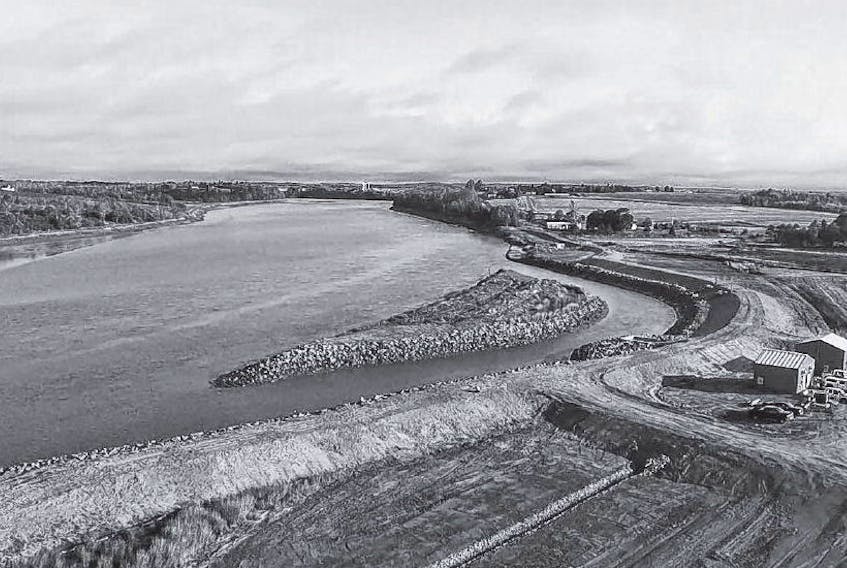here won’t be any natural gas stored under Colchester County before 2021.
“There is a revised in-service date for service,” AltaGas spokeswoman Lori MacLean said Thursday. “The reason for that is the brining process to create the caverns takes about two or three years to complete. Since brining has not yet started, the new service date simply reflects that fact.”
Alton Natural Gas Storage LP, a subsidiary of AltaGas, plans to draw nearly 10,000 cubic metres of water daily from the Shubenacadie River estuary at Fort Ellis and propel it through a 12-kilometre underground pipeline to the Brentwood Road cavern site. There, the water will be pumped nearly 1,000 metres underground to flush out salt to create two caverns that will each be about the size of an average office building capable of storing up to six billion cubic feet of natural gas.
The brine created by the salt dissolution will then be pumped back to the estuary for release into the river system, a gradual discharge of 1.3 million cubic metres of salt over the two- to three-year period.
Environmental groups, residents living near the cavern site and the Mi’kmaq community have vehemently opposed the project. Members of the nearby Sipekne’katik Band set up a truckhouse near the river site nearly two years ago to facilitate their ongoing protest that is centred around the salt to be discharged into the river. They say it will adversely affect fish and other wildlife. The band also has a small trailer set up by the main gate to Alton’s riverside property.
The plan was to begin storing natural gas in 2020, but the date has now been moved to 2021. Chief Mike Sack said Thursday he was aware of the changed service date.
“I found it interesting that it was pushed back for a year,” he said.
The provincial Environment Department approved an environmental assessment for the brining process in 2016. The band appealed the approval and the department denied the appeal. When the band took the case to the Nova Scotia Supreme Court and won, its initial appeal was sent back to the minister and the judge ordered the department to further consult with the band.
“We haven’t been in contact with anybody lately,” Sack said. “I’m waiting to get a meeting with our lawyers to see what’s up there.”
A department spokeswoman said Thursday there is no update on the Alton project.
“The minister continues to review the submission,” she said, adding that the department is not aware of any deadline for further consultation.
MacLean said the company has been engaging with all the stakeholders in the project from the start.
“We have regular dialogue with a variety of stakeholders, including Sipekne’katik First Nation, and we’ve been sharing science and technical information about the project to help answer questions that the community may have had.”
The project has been fraught with delays for several years, but MacLean said the protests have not been the cause.
“We’ve been respectful of the protesters,” she said. “People have the right to peacefully protest and express their opinions. That said, the river site is open only to Alton employees and approved contractors. So we’ve been in regular contact with local authorities, including the RCMP, regarding protesters and their activity at the site.
“We will continue to work with law enforcement and the local community, First Nations and others as we progress toward the start of brining.”
MacLean said construction at the site is basically paused.
“There was a substantial amount of construction that took place in 2016 to get the river site ready for the brining process. That was essentially completed, although there is a bit more work to be done there. Then, in 2017, we engaged in a fair bit of engagement with stakeholders, community groups, that sort of thing, as construction itself paused.”
MacLean said the delay in the startup should not be construed as the company abandoning the project. She said brining will start sometime this year.
“Plans are being put together for that now, so we don’t have a more specific date at this time. But the plan is to begin this year. It’s (2021 startup) merely an adjustment in the timeline to recognize the brining process will take two to three years to complete.”
MacLean said some view the environmental assessment as the end of company and government oversight, but that is not the case.
“The process does not stop with the environmental assessment. In fact, you could say that the environmental assessment is but one step in the overall process.
“Since the completion of the environmental assessment, there have been a number of studies and reports that have been completed, which are all on our website. Since the completion of the environmental assessment, there was, as well, the third-party independent review, which was led by the Nova Scotia Assembly of Mi’kmaq Chiefs, to thoroughly review the project. The outcome of that review was a number of recommendations that the project has fully adopted.”
Those recommendations included plans for a longer shutdown in the brining process during bass spawning to protect striped bass, their eggs and young fish.
“Layered on top of that, you have the 10 years of scientific research that the experts at Dalhousie University have done, which has gathered an enormous amount of data about the estuary and its physical characteristics,” MacLean said.
Dalhousie is also conducting another study into the salinity tolerance for striped bass, and results are expected soon, she said.









